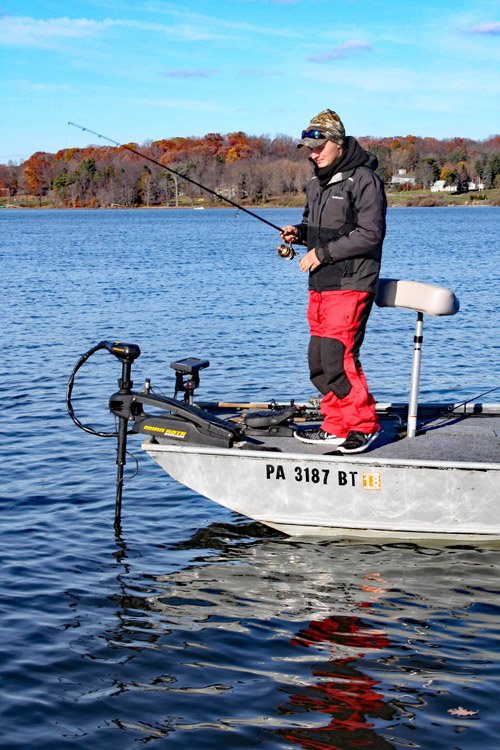Many of Darl Black’s friends agree: the late fall crappie bite in western Pennsylvania is the most consistent day-to-day fishing of the entire season. The deepwater crappies are in no hurry to go anywhere, and more fish continue to arrive – at least until ice-up. (Photo: Darl Black)
Going Straight Down in Late Fall
by Darl Black
Late Fall Bonanza – Vertical presentation for northern crappies in cold water
November signals the arrival of cold water (below 50 degrees) across the lower Great Lakes, Mid-Atlantic and lower New England. As the summer thermocline on the deepest lakes breaks up, the depths are rejuvenated with oxygenated water. Forage fish and prey fish are no longer restricted to the upper part of the water column.
In northwest Pennsylvania, the most consistent crappie bite of the entire season takes place in November and early December. Once located, late fall crappies are more dependable to stay put than spring and summer fish, plus there are fewer anglers on the water.
On large bodies of water, late fall crappies will migrate to deeper structure, suspending just above bottom cover such as stumps or brushpiles/cribs in reservoirs, and over rock outcroppings or the slopes of hard bottom humps in natural lakes. The depth at which crappies will be found varies from 15 to 40 feet depending on the make-up of the lake or impoundment. On shallow “dishpan” shaped “ponds” which lack cover or hard bottom, crappies generally move into the deepest available water.

Regardless of depth, the best presentation for these cold-water crappies is a direct line. Position the boat above the suspected crappies and fish straight down. My choice of baits has changed only slightly over the last 40 years as I learned some new tweaks to the basic presentations.
Dancing a Spoon: A jigging spoon was the first artificial lure I used for cold-water crappies back in the 70s. I stumbled onto it while spoon jigging for walleyes – darn crappies smacked it, too! Downsizing to a 1/4 or 3/8-ounce Hopkins or Kastmaster, and swapping out the heavy hook for a light wire #6 treble hook insures more positive hook ups. I generally use a spinning rod with 8-pound Gamma Edge fluorocarbon line. Be sure to use a quality ball-bearing snap swivel to reduce line twist.
Once suspected crappies are discovered on electronics, simply open the bail and let the spoon fall to the bottom. Then reel in line to bring the spoon to just above the level which crappies are seen on sonar. With practice, you can keep the spoon within the cone angle of the sonar so you know exactly where to hold it.
The jigging technique is simple. First, with rod about parallel to water surface, lightly shake the rod tip to dance the spoon for several seconds. Then hold the spoon steady for maybe five seconds before shaking it again. Next, lift the spoon about two feet with the rod tip, then slowly drop the rod tip to the water’s surface so the spoon free falls a couple feet before stopping it and shaking/pausing it again. Hits usually come on the pause or the free fall rather than when shaking.
Burping a Vibrator: Shortly after learning spooning, the Heddon Sonar blade bait became my favorite deepwater fall lure. Whether using a Sonar, Silver Buddy, Cicada or the newest one – Steelshad, all are fished in the same manner. Drop it to the bottom, take up some line so the blade rests at the approximate depth of observed crappies, then lift the blade until you feel it vibrate. Stop and slowly lower the blade back down, then repeat. This vibration really triggers crappies. Watch it on your sonar.

Two years ago, professional angler Dave Lefebre told me of his success on cold-water crappies using a 5/16-ounce Rapala Rippin’ Rap in the same manner that I used a blade bait. While fishing with Rick Como on Shenango Lake last November for white bass and crappies, Rick starting yo-yoing a lipless crank just as Lefebre had described. I tried it. Fantastic results! The lipless vibrating crankbait might even be better than the metal-fin blade bait because the bulky plug falls slower.
Bumping a Baby Shad: Years ago, I would drop a 3/16-ounce jig tipped with a minnow to deepwater brushpiles in the late fall. But when introduced to drop-shotting for bass fishing, I quickly realized how this presentation was ideal for crappies in and around cover. My crappie drop-shot rig consists of a two-inch Bobby Garland Baby Shad on a small 1/32-ounce jighead, a cheap snap swivel and a bell sinker.
Tie the jighead with attached Baby Shad to the main line with a loop knot, leaving about 24 inches of line. To the tag end of the line, tie an inexpensive snap-swivel. Depending on the depth and the strength of the breeze, clip a 1/4, 3/8, or 1/2-ounce bell sinker into the snap.
Drop the rig down to the cover, and slowly feel around with the sinker. When you bump wood, lift the rig gently, move a bit and lower it back down. The loop attachment keeps the Baby Shad moving freely, and the lead to the sinker greatly reduces snagging. Feel a pull or tug – set the hook!


